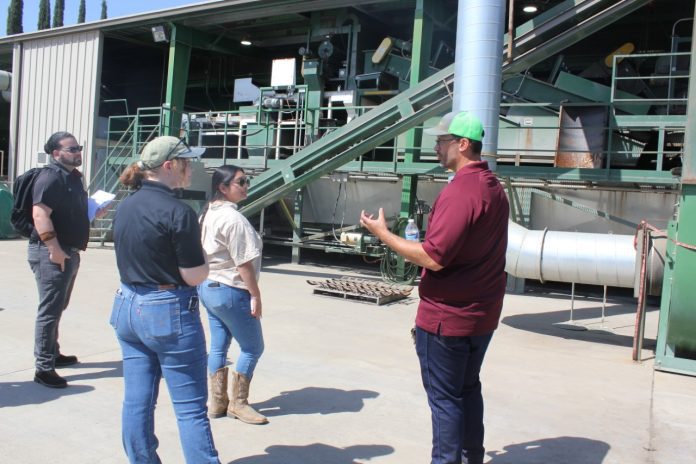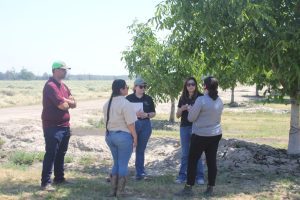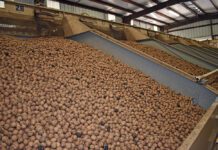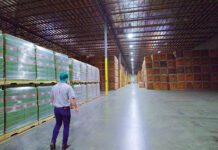
Walnut and pistachio growers along with huller operators should be aware that routine Produce Safety Rule (PSR) inspections, with prior notice, will take place and be carried out by California Department of Food and Agriculture’s Produce Safety Program inspection teams, under authority of the U.S. Food and Drug Administration, to make sure the Produce Safety Rule is being followed on farms.
Farm and huller inspections should not be a dreaded event and no punitive action should be anticipated, Roger Isom, Western Agricultural Processors Association president, said. “It’s more like an open book test. They want you to be aware of any potential issues with food safety.”
CDFA Produce Safety Program Supervisor Sarah Standiford added that only if egregious food safety conditions are observed will enforcement actions be taken. “This is relatively very rare, but the regulatory process allows for this to protect public health.”
In preparation for inspections, WAPA and CDFA coordinated regional on-farm readiness reviews in April and May to ensure tree nut growers and hullers are prepared for the Food Safety Modernization Act’s Produce Safety Rule. CDFA’s PSR inspections have been occurring since 2018 and inspection elements that went into effect in January of this year for large farms with annual produce sales greater than $500,000 (averaged over the previous three years and adjusted for inflation) are harvest and postharvest water requirements. The same harvest and postharvest water requirements will go into effect for small farms with annual produce sales of $250,000 to $500,000 (averaged over the previous three years and adjusted for inflation) in January 2024 and for very small farms with annual produce sales of $25,000 to $249,000 (averaged over the previous three years and adjusted for inflation) in January 2025.
The Process
The Produce Safety Rule establishes mandatory, science-based, minimum standards for the safe growing, harvesting, packing and holding of walnuts and pistachios along with fruits and vegetables grown for human consumption. The rule covers worker health, hygiene and training; agricultural water quality in pre-harvest and postharvest; biological soil amendments of animal origin; domesticated and wild animals; equipment; tools; buildings; and sanitation. The point of the PSR is to prevent adulteration of food on farms and during processing.
At the first scheduled on-farm readiness review, CDFA inspectors conducted a mock inspection at Summerfield Farms in Hanford to demonstrate to growers and huller operators present what an official farm inspection will entail and what documentation they will be required show inspectors.
The CDFA inspection team of Carolyn Chandler, Estrella Perez and supervisor Sarah Standiford emphasized that along with inspecting for compliance, outreach, education and technical assistance are part of the program. Inspectors are required to review documentation of cleaning, sanitation and training. The inspections are not a “gotcha” approach, Standiford said, but a way to inform growers when corrective action is needed. Many parts of the rule are common sense, Chandler said.
“We want to see if you have a plan to fix a minor issue.”
Chandler said there is a variety of options for compliance in all parts of the PSR and suggested growers select which option works best for their operation.
David Stanfield of Summerfield Farms took part in the mock inspection at the walnut huller and drying facility, going over each part of the rule that applied and how the rule is followed. Standiford said there must be awareness at the facility of any possibility of contamination.
Starting with human health and hygiene, Stanfield said the policy is observation of workers and visitors for signs of illness, open sores or wounds. Workers are expected to wear closed-toe shoes and not wear loose clothing. Employee training is a significant part of PSR compliance. Stanfield said the full-time crew has annual training and seasonal workers have their training when they start at harvest. Training includes interpretation for non-English speaking employees, video and a handbook that covers all potential food contamination issues. Stanfield said they are asked to read the book and sign that they have read and understand the rules. Handwashing demonstrations are included, and at pre-harvest their employees do field checks to check for any potential safety hazards. There is a permanent schedule for restroom cleaning at the huller and the third-party certification for clean portable restrooms.
Meeting Requirements
Summerfield Farms does apply biological soil amendments of animal origin in its walnut orchards, Stanfield said, and complies with the 120-day application prior to harvest timing requirement. The compost, he said, is produced in a validated process and comes with a certificate of compliance. He also documents how the compost is spread in the orchards and how it is stored prior to application to prevent runoff. Standiford said inspectors typically look for documentation related to details of compost production and logs or records of application.
Prevention of food product contamination from wild or domestic animals is another PSR requirement that inspectors will ask about. Stanfield said in the field, machine operators who observe any animal intrusion are required to dump product. In the huller, Stanfield said monitoring and prevention is key. They monitor for bird nests and rodents. An example of a tricky situation in PSR compliance is intrusion by a federally protected species. In that case, consultation with local wildlife authorities may be needed to determine measures that can be taken and documented to ensure produce safety, Chandler said.

Stanfield continued that machinery that has come into contact with an animal carcass is cleaned and sanitized before going back into the field for use in harvesting. At the huller, Stanfield said there is a pre-season sanitation routine that includes belt cleaning and sanitation. Trash in the orchards is another issue that must be addressed. Stanfield told inspectors there is a checklist that is followed before harvest begins.
The FDA is proposing to revise certain pre-harvest agricultural water requirements. If finalized, the proposal would require a systems-based pre-harvest water assessment, and the grower would be required to evaluate the factors that could be likely to cause microbial contamination of produce. The factors include but are not limited to the water system location and water source, type of irrigation and environmental conditions. Farms growing produce covered in the PSR would have to do an annual assessment of water quality, keep written records and maintain documentation.
Float tanks in walnut and pistachio hullers are part of an inspection. Chandler said during an inspection, they will ask the operator what they are doing to maintain clean water and sanitation of any food contact surfaces. If antimicrobials are used, documentation should include what kinds and how often they are used.
Standiford said it is rare for on-farm inspectors to witness major food safety threats. If they do, agencies with appropriate enforcement authorities such as the California Department of Public Health and/or FDA would get involved.
Routine Produce Safety Rule inspections are usually pre-announced and occur within five days. A person at the farm who oversees produce safety accompanies the inspectors. The designated person should be able to answer questions about growing, harvesting and packing procedures. Inspectors will explain what is being looked at and why, and if there are any regulatory concerns, the inspector will discuss and explain reasons. Inspectors will also provide inspection documentation.

Cecilia Parsons | Associate Editor
Cecilia Parsons has lived in the Central Valley community of Ducor since 1976, covering agriculture for numerous agricultural publications over the years. She has found and nurtured many wonderful and helpful contacts in the ag community, including the UCCE advisors, allowing for news coverage that focuses on the basics of food production.
She is always on the search for new ag topics that can help growers and processors in the San Joaquin Valley improve their bottom line.
In her free time, Cecilia rides her horse, Holly in ranch versatility shows and raises registered Shetland sheep which she exhibits at county and state fairs during the summer.















